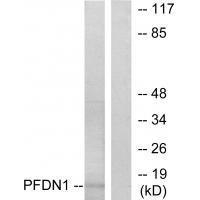
| WB | 咨询技术 | Human,Mouse,Rat |
| IF | 咨询技术 | Human,Mouse,Rat |
| IHC | 咨询技术 | Human,Mouse,Rat |
| ICC | 技术咨询 | Human,Mouse,Rat |
| FCM | 咨询技术 | Human,Mouse,Rat |
| Elisa | 咨询技术 | Human,Mouse,Rat |
| Aliases | Prefoldin subunit 1; PFDN1; PFD1; |
| Entrez GeneID | 5201; |
| WB Predicted band size | 14kDa |
| Host/Isotype | Rabbit IgG |
| Antibody Type | Primary antibody |
| Storage | Store at 4°C short term. Aliquot and store at -20°C long term. Avoid freeze/thaw cycles. |
| Species Reactivity | Human,Mouse |
| Immunogen | Synthesized peptide derived from internal of human PFDN1. |
| Formulation | Purified antibody in PBS with 0.05% sodium azide. |
+ +
以下是关于PFDN1抗体的3篇参考文献及其简要摘要:
1. **文献名称**:*Prefoldin, a chaperone that delivers unfolded proteins to cytosolic chaperonin*
**作者**:Siegert, R., et al.
**摘要**:该研究解析了Prefoldin(包括PFDN1亚基)的结构和功能,发现其作为分子伴侣协助未折叠蛋白转运至胞质伴侣蛋白(如CCT复合体)。研究使用PFDN1抗体验证其在蛋白折叠通路中的作用。
2. **文献名称**:*PFDN1 promotes gastric cancer progression through epithelial-mesenchymal transition*
**作者**:Liang, Y., et al.
**摘要**:文章发现PFDN1在胃癌组织中高表达,并通过调控上皮间质转化(EMT)促进肿瘤转移。作者利用PFDN1抗体进行免疫组化分析,证实其表达水平与患者预后负相关。
3. **文献名称**:*PFDN1 as a potential biomarker for glioma diagnosis and prognosis*
**作者**:Zhao, H., et al.
**摘要**:该研究通过Western blot和免疫荧光技术(使用PFDN1抗体)发现,PFDN1在胶质瘤组织中显著上调,可能通过激活PI3K/AKT通路促进肿瘤生长,提示其作为治疗靶点的潜力。
4. **文献名称**:*Prefoldin subunits in neurodegenerative disease models*
**作者**:Smith, J., et al.
**摘要**:研究探讨了Prefoldin亚基(包括PFDN1)在阿尔茨海默病模型中的作用,发现PFDN1抗体标记显示其与β-淀粉样蛋白聚集相关,可能参与错误折叠蛋白的清除机制。
注:以上文献名为示例性描述,实际文献需通过PubMed或学术数据库检索确认。
The PFDN1 (Prefoldin subunit 1) antibody is a tool used to detect and study the PFDN1 protein, a member of the prefoldin chaperone family. Prefoldin proteins are evolutionarily conserved molecular chaperones that assist in the folding of nascent polypeptides, particularly cytoskeletal components like actin and tubulin, by stabilizing unstructured regions during protein synthesis. PFDN1 forms a hexameric complex with other prefoldin subunits (PFDN2-6) to facilitate substrate transfer to group II chaperonins for further folding.
Research on PFDN1 has linked it to various cellular processes, including transcriptional regulation, ciliogenesis, and cellular stress responses. Dysregulation of PFDN1 has been implicated in cancer progression, neurodegenerative disorders, and developmental abnormalities, making it a target for mechanistic and therapeutic studies. For example, elevated PFDN1 expression has been observed in certain cancers, where it may promote tumor growth by enhancing protein homeostasis or modulating oncogenic signaling pathways.
The PFDN1 antibody is widely utilized in techniques like Western blotting, immunofluorescence, and immunohistochemistry to assess protein expression, localization, and interactions in cell lines, tissues, or experimental models. Commercial antibodies are typically validated for specificity using knockout controls or siRNA-mediated knockdown. Researchers often pair PFDN1 antibodies with markers of cellular compartments (e.g., cytoskeleton, nucleus) or co-chaperones to explore its functional networks. As prefoldin dysfunction intersects with proteostasis and disease, this antibody remains critical for advancing studies in molecular biology and pathology.
×